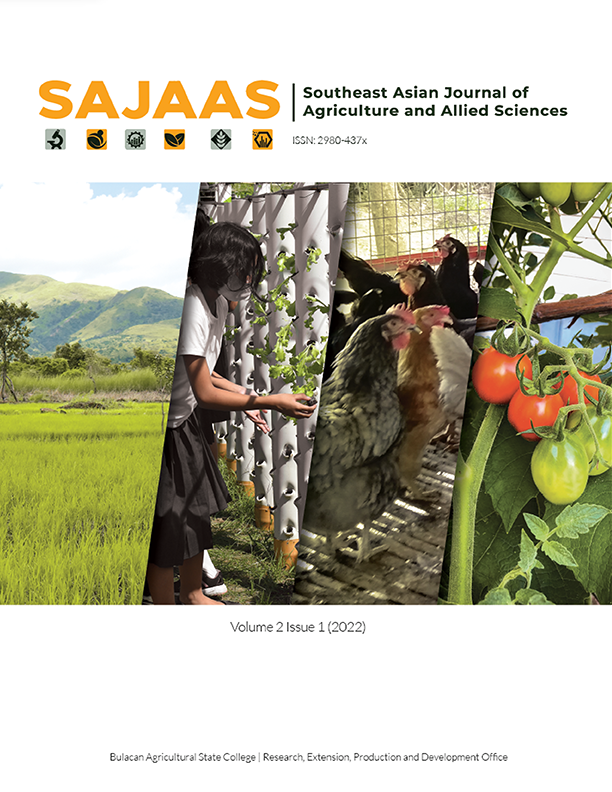Abstract
The study was conducted to determine the response of Cobb® Broiler to different mixture formulations of D-Glucose Monohydrate and multivitamins. Specifically, it determined the growth performance, mortality rate, chick quality, and harvest recovery of Cobb® broiler as affected by different mixtures of D-Glucose Monohydrate and different gel consistency (soft, medium and hard). The experiment used a total of 1,440 chicks from the hatchery following the 2 x 3 factorial in Completely Randomized Design. There were six treatment combinations, and each was replicated three times. Each replication had 80 Cobb® broiler chicks to ensure validity of data. The results of the study showed better chick quality (Pasgar) score for mixture 2 (with higher amount of D-glucose monohydrate) only on Day 0 (farm) immediately right after the transport and at day 4, but no significant differences at day 7. In terms of gel consumption rate, Mixture 2 also had significantly higher consumption than mixture 1, significantly. In terms of body weight, gain in weight, harvest recovery, and mortality rate there were also no significant differences among treatments with different nutrient mixtures and gel consistency.
References
Abreu, L. H., Yanagi, T., Campos, A. T., Bahuti, M., & Fassani, É. J. (2017). Cloacal and surface temperatures of broilers subject to thermal stress. Engenharia Agrícola, 37, 877-886.
Asghar, A., Morita, J. I., Samejima, M., & Yasui, T. (1984). Biochemical and functional characteristics of myosin from red and white muscles of chicken as influenced by nutritional stress. Agricultural and Biological Chemistry, 48 (9), 2217-2224.
Baião, N. C., Cançado, S. V., & Lucio, C. G. (1998). Effect of hatching period and the interval between hatching and housing on broiler performance. Arquivo Brasileiro De Medicina Veterinária E Zootecnia, 50(3), 329-335.
Bayliss, P. A., & Hinton, M. H. (1990). Transportation of broilers with special reference to mortality rates. Applied Animal Behaviour Science, 28(1-2), 93-118.
Bergoug, H., Guinebretiere, M., Tong, Q., Roulston, N., Romanini, C. E. B., Exadaktylos, V., & Michel, V. (2013). Effect of transportation duration of 1-day-old chicks on postplacement production performances and pododermatitis of broilers up to slaughter age. Poultry Science, 92(12), 3300-3309.
Boerjan, M. (2006). Chick vitality and uniformity. International Hatchery Practice, 20(8), 7-8.
Christensen, V. L. (2001). Factors associated with early embryonic mortality. World's Poultry Science Journal, 57(4), 359-372.
Council Regulation (EC) No 1/2005 of 22 December 2004 on the protection of animals during transport and related operations and amending Directives 64/432/EEC and 93/119/EC and Regulation (EC) No 1255/97.
Directive, C. (2007). 43/EC of 28 June 2007 laying down minimum rules for the protection of chickens kept for meat production. Official Journal of the European Union, 182, 19-28.
Foote, M. (2019). Chick Quality. Availed from: https://www.cobb-vantress.com/assets/EMEA-Best-Management-Practices/4ba333d62d/Mark-Foote-Chick-Quality-Article-2019.pdf.
Heier, B. T., Høgåsen, H. R., & Jarp, J. (2002). Factors associated with mortality in Norwegian broiler flocks. Preventive Veterinary Medicine, 53 (1-2), 147-158.
Jacobs, L., Delezie, E., Duchateau, L., Goethals, K., Ampe, B., Lambrecht, E., & Tuyttens, F. A. (2016). Effect of post-hatch transportation duration and parental age on broiler chicken quality, welfare, and productivity. Poultry Science, 95 (9), 1973-1979.
Jacobs, L., Delezie, E., Duchateau, L., Goethals, K., & Tuyttens, F. A. (2017). Impact of the separate pre-slaughter stages on broiler chicken welfare. Poultry Science, 96 (2), 266-273.
Lin, H., Zhang, H. F., Jiao, H. C., Zhao, T., Sui, S. J., Gu, X. H., & Decuypere, E. (2005). Thermoregulation responses of broiler chickens to humidity at different ambient temperatures. I. One week of age. Poultry Science, 84 (8), 1166-1172.
Mitchell, M. A. (2009). Chick transport and welfare. Avian Biology Research, 2(1-2), 99-105.
Moran Jr, E. T. (2007). Nutrition of the developing embryo and hatchling. Poultry Science, 86(5), 1043-1049.
Oviedo-Rondón, E. O., Wineland, M. J., Small, J., Cutchin, H., McElroy, A., Barri, A., & Martin, S. (2009). Effect of incubation temperatures and chick transportation conditions on bone development and leg health. Journal of Applied Poultry Research, 18(4), 671-678.
Peebles, E. D. (2018). In ovo applications in poultry: a review. Poultry Science, 97 (7), 2322-2338.
Quinn, A. D., & Baker, C. J. (1997). An investigation of the ventilation of a day-old chick transport vehicle. Journal of Wind Engineering and Industrial Aerodynamics, 67, 305-311.
Soczu, A. and Ipek, A. Quality assessment chicks from different hatcher temperatures with different scoring methods and prediction of broiler growth performance. Journal of Applied Animal Research, 43 (4): 409-416.
Uni, Z., Yadgary, L., & Yair, R. (2012). Nutritional limitations during poultry embryonic development. Journal of Applied Poultry Research, 21 (1), 175-184.
Van de Ven, L.J.F., van Wagenberg, A.V., Uitdehaag, K.A., Groot Koerkamp, P.W.G., Kemp, B., and van den Brand, H. 2012. Significance of chick quality score in broiler production. Animal, 6 (10): 1677-1683.
Willemsen, H., Everaert, N., Witters, A., De Smit, L., Debonne, M., Verschuere, F., Garain, P., Berckmans, D., Decuypere, E., and Bruggeman, V. 2008. Critical assessment of chick quality measurements as an indicator of posthatch performance. Poult Science, 87: 2358-2366.
Yerpes, M., Llonch, P., & Manteca, X. (2020). Factors associated with cumulative first-week mortality in broiler chicks. Animals, 10 (2): 310.
Yerpes, M., Llonch, P., & Manteca, X. (2021). Effect of environmental conditions during transport on chick weight loss and mortality. Poultry Science, 100 (1), 129-137.

This work is licensed under a Creative Commons Attribution-NonCommercial-ShareAlike 4.0 International License.
Copyright (c) 2022 Southeast Asian Journal of Agriculture and Allied Sciences

